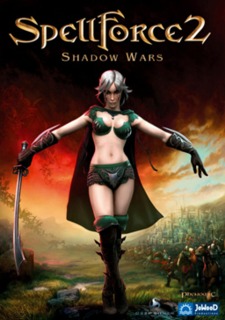INTRO:
SpellForce 2: Shadow Wars was a vast improvement over its very flawed predecessor, the first SpellForce game. Developer JoWood deserves credit for learning from its past experiences, but this kudos would be diluted by the expansion pack which is Dragon Storm.
DRM:
Even up to the Gold edition of Spellforce 2, Phenomic, which is the publisher for the game, was still a firm believer in DRM, specifically CD-keys. Looking at a long string of characters and entering them into a long input tab has been and still is boring, even irritating. Unfortunately, up until now, Phenomic had not seen fit to remove this code from the current build of its product.
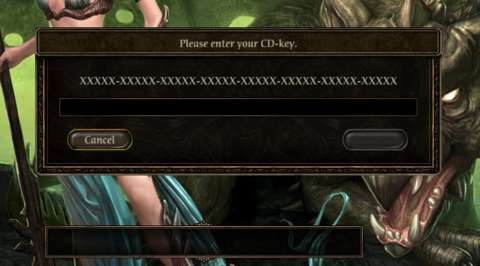
PREMISE:
The story of Dragon Storm appears to be a sequel to that in Shadow Wars, though this is not immediately apparent. Although Shadow Wars did end with the Shaikan protagonist, his/her kin and allies mostly safe, where they went next is not immediately clear. However, the player will be given revelations on their fate later, and they give significance to the title “Dragon Storm”.
Anyway, in Dragon Storm, the conflict in Shadow Wars have been resolved to a degree. The army of steel demons and the villain who tried to raise them has been defeated, but at great cost to the Shaikan. However, the Shaikan have since obtained for themselves a new home, and developed a lifestyle which utilizes their dragon-blooded talent.
Moreover, the world is still falling apart, the consequences of the resolution of the story of the previous SpellForce game still being felt.
This is apparent from the prologue of the story of the expansion. It occurs at Winterlight Peak, one of the homes of the Dwarves. The protagonist is apparently a Shaikan, one of the members of the mercenary Shaikan force which has been sent to aid the Dwarves, whose home is under siege by the Clans faction.
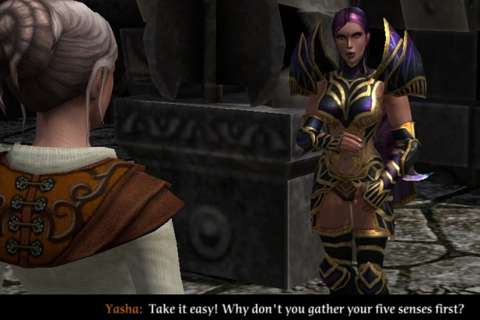
By looking around and talking to the first two NPCs, the player finds out that due to a less-than-successful rescue attempt, the Shaikan protagonist has succumbed to the cold of the mountains, though the perks of being a Shaikan is that he/she is immune to harm from the cold. However, the Shaikan was frozen stiff anyway from the elements anyway and lost consciousness.
Unfortunately, the protagonist reawakened at a bad time, specifically the imminent victory of the Clans.
After talking to the aforementioned two NPCs, the player learns that this Shaikan is not the same as the one in Shadow Wars. Instead, this Shaikan is one of the Rune Warriors of old, apparently turned into a Shaikan some time ago.
Due to guilt and need for a noble purpose as is typical of most former Rune Warriors, the expansion’s protagonist has decided to strike out on his/her own, lending a helping hand to anyone in need.

However, as a consequence of the protagonist’s philanthropic inclinations, the overarching plot of Dragon Storm develops slowly. The player will be forced to help a lot of people before the protagonist comes across a long-term goal.
CAMPAIGN PROTAGONIST:
As in the original package of SpellForce 2, the expansion pack has the player creating a player character for the campaign mode in Dragon Storm. This is not the same player character as the one in the Shadow War, so the player cannot import a character from that campaign.
For the Dragon Storm campaign, the player character starts at level 10. This is fitting, because the campaign starts with challenges which are suitable to a level 10 hero/heroine.
The player character’s looks, gender and vocation are completely unimportant to the story, so it is up to player to make all kinds of combinations on either a whim or deliberate practicality.
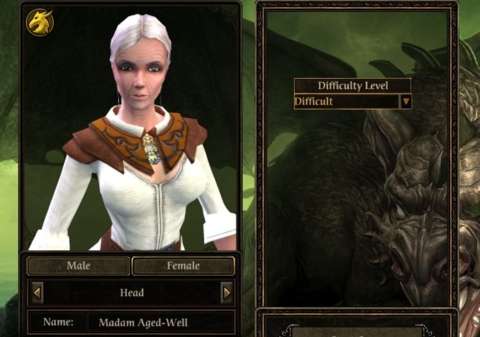
Like in the original campaign, the player character is the only member of the party which is capable of having a skill toolbar with more than just three slots. He/She is also at least three levels ahead of the other party members, with the gap growing to six levels when the player character is at level 30. He/She is also the only one still capable of using Journey Stones, and has to summon party members over to his/her side after using them.
In other words, all of the limitations of the player character – and complaints about them – were retained from Shadow Wars.
This lack of change would not be pleasant to Shadow War veterans who have wished that this aspect of the game could have been improved.
Still, there may be some amusement to be had from the narrative designs behind the main player character; he/she is an incredibly helpful person, apparently incapable of saying no to any plea for help or any challenge.
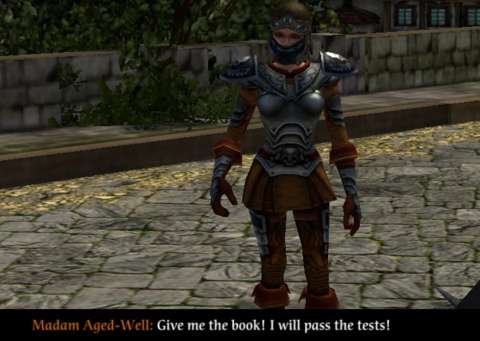
RETAINED SKILL TREES:
The skill trees for magic and combat “arts” have been retained from Shadow Wars. Like in Shadow Wars, the player must allocate the points which party members have accrued from levelling up in arts. He/she cannot hoard them to spend them all in one branch of the skill tree, because the game retains the requirement of player characters having spent a certain number of points in any arts before being allowed to advance their arts further.
In the previous game package, this resulted in the player having to put points into arts which he/she does not want for a player character. For example, if the player does not want a character to use magic, he/she must spend his/her points into combat arts. Yet, this dilutes the character’s potency anyway, because the two combat arts, Light Combat and Heavy Combat, have mutually exclusive benefits.
However, the Dragon Storm campaign mitigates this issue by introducing a new tree of skills, some of which are useful if only because they act as alternate requirements for the use of gear.
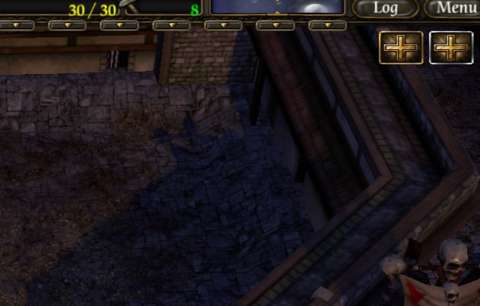
SHAIKAN SKILL TREE:
New to the expansion is the Shaikan skill tree for heroes. The magical properties of the Shaikan’s blood have been mentioned a few times in the story of Shadow Wars; they also appear in the gameplay as their ability to be resurrected soon after death, among other abilities like being able to use Journey Stones.
However, this was the extent of their abilities gameplay-wise. This might have seemed like many loss of opportunities to make more use of the Shaikan’s magic for gameplay purposes.
Dragon Storm offers new gameplay content which do make use of the Shaikan’s magic; this content is also associated with a new type of damage, which will be described later.
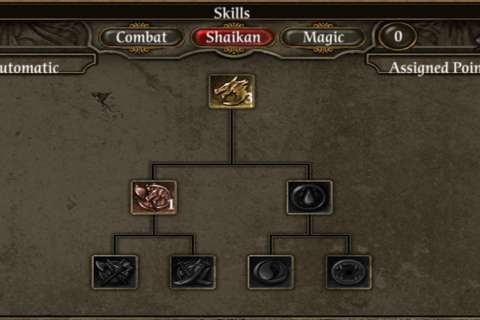
Every Shaikan party member has access to the Shaikan skill tree. This skill tree does not have many entries, but what there are complements the player’s choices in going down either the Combat or Magic Art trees.
Among these Shaikan skills are spells which can summon autonomous weapons which cannot be attacked or damaged by enemies in any way. They act as extra firepower and also help displace enemies such that they cannot surround the player’s close-combat assets.
Next, there are higher-level Shaikan arts which act a lot like the skills in the other arts. For example, there are special melee attacks in the Shaikan skill tree which resemble the special attacks in the Combat Art skill trees. However, the Shaikan versions have additional properties, such as doing damage over time or reducing the target’s resistances.
The main properties of these skills is their use of so-called “blood damage”, which will be described shortly. Their secondary benefit may seem more useful than their supposedly primary benefits though; the Shaikan arts double as alternate prerequisites for the equipping of items, which allows for combinations such as an archery-oriented hero making use of heavy armor.
This is of particular usefulness in the Campaign and Free Game modes, in which the player may need to have characters switch out equipment to deal with different challenges.
SKILL TOOLBAR:
For better or worse, the skill toolbar, which is part of the game’s “Click-n-Fight” system (to use JoWood’s own terms), has retained its strengths and limitations from the previous game. The player can stock a skill toolbar, and afterwards entries in the toolbar appear according to what characters can do to a selected unit, be it player-owned or of the enemy.
This convenience, which rewards micromanagement, still comes with the drawback of the skill toolbars crowding up the left side of the screen.
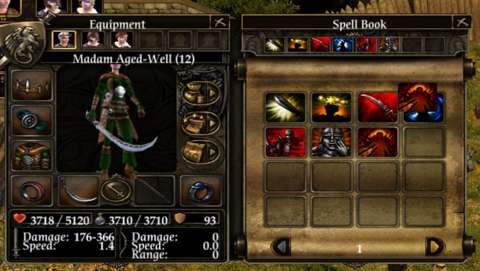
BLOOD DAMAGE:
“Blood damage” may have a weird name, but then, Shadow Wars had made use of nomenclature such as “black damage” and “white damage”. “Blood damage” is practically just another type of damage.
Blood damage is the main way to get around the resistances of units which have been known in Shadow Wars for being particularly resistant to magic. Incidentally, some units which do not have resistances in the previous version of SpellForce 2 have been reworked to have resistances to blood damage, which make them counters to Shaikan magic and the Shaikan faction.
SHAIKAN FACTION:
Speaking of which, joining the Realm, Clans and Pact factions is the new Shaikan faction. As mentioned earlier, the Shaikan have become mercenaries, a fate which allow them to find work to survive and also express their abilities through magical and martial means. Through the single-player campaign, the sub-factions of the Shaikan faction is also introduced, namely the Blades and the Dragons.
Most of the abilities of the regular Shaikan units concern the use of blood damage. Many of the units of the other factions do not have resistance to blood damage, so Shaikan units can inflict a lot of damage if the opposition is not prepared with counters. These advantages are often provided through their unit upgrades.
Unit upgrades is a system which appears to be unique to the Shaikan faction. The player is given a pair of mutually exclusive options for each type of regular Shaikan unit. Any currently active option imparts special abilities onto regular Shaikan units which are created afterwards. For example, the Vanguard unit can be turned into a ranged/melee hybrid with the Javelin upgrade.
Switching upgrade options costs considerable resources, so this should be done wisely. Moreover, switching options does not alter existing units who already have upgrades. Returning to a map in the campaign mode also happens to reset upgrade options, though upgraded units retain their upgrades.
Shaikan units do not appear to benefit from the ability to revive from death like heroes do; instead, they have to rely on Shaikan units known as Blood-mages. Neither can Shaikan units use Journey Stones. Perhaps these limitations were intended for gameplay balance, but they cause a disconnect between the narrative of the Shaikan’s canon and the gameplay of Dragon Storm.
Next, there are the Blades. Veterans of the previous SpellForce games might recognize them, though to elaborate on this statement is to mention spoilers. Yet, it has to be mentioned here that JoWood’s writers have used some rather convenient plot twists to include such unlikely additions to the Shaikan faction.
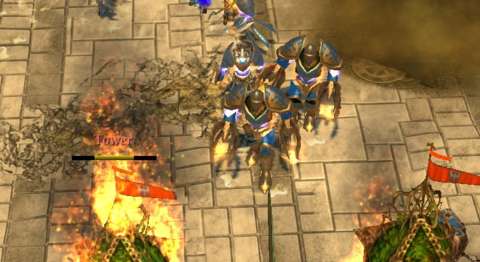
The Blades can be considered as powered-up versions of regular units, coupled with a lot of resistances (especially towards Mental-type damage).
The Dragon sub-faction is perhaps the most exciting contribution from Dragon Storm to the SpellForce series. In fact, this sub-faction can be considered the titular namesake of the game.
To elaborate, the Shaikan player can build a (rather massive) dragon den, which in turn can be used to raise three types of dragon-kind.
One of these is comparatively less impressive than the other two, because it is a ground-pounding dragon. Still, it is very difficult to kill, because it has impressive regeneration.
The other two dragon units are flight-capable, and together, they are a terrifying force to deal with as long as they still have mana to power their spells. One is a fire drake which can ruin buildings and set alight swathes of enemy units; the other is capable of levelling armies with immense mental shockwaves (few, if any, other units can do such shockwaves).
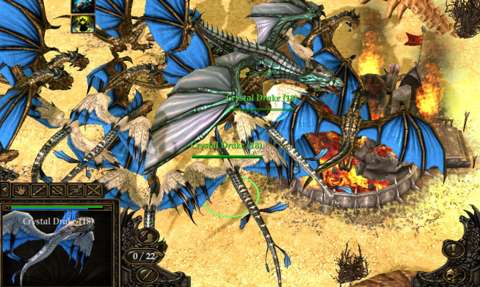
Considering the advantages of the Shaikan faction, they can seem terribly unbalanced. JoWood attempts to balance it by sticking Shaikan units with high unit slot and resource costs, meaning that the Shaikan have the disadvantage of numerical inferiority.
This is not exactly an effective setback though, because smart players might mix and match the abilities of different units to create a powerful army which can knock out other armies before the latter can grind them down in battles of attrition.
PATHFINDING ISSUES:
Shadow Wars had problems in the pathfinding scripts of its units, which just could not seem to handle the very varied topography of the maps in SpellForce 2. More often than not, units turn around when they could not move past the ones in front of them, only to bump into incoming units, who in turn repeat the same behaviour. This causes units to fall behind.
Forcing group-moving mitigates the straggling of units, but does not solve the issue of units bumping into each other and getting confused.
Unfortunately, the topography of the maps in Dragon Storm had not been fine-tuned to accommodate the idiocy of units. Furthermore, for the campaign, the camera and the size of edifices such as palaces compound the problem further.
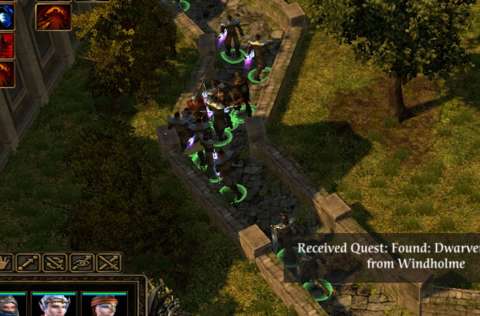
The pathfinding issues also occur when the player is attempting escort-oriented quests. NPCs which the player is trying to rescue are similarly lousy at pathfinding. The most which the player could do to mitigate is to realize that they follow the main player character around, so the player could have the main player character escorting them alone such that the player’s other units do not get in the way.
SKIRMISH & MULTIPLAYER:
These aspects will be explained before the gameplay of the Campaign and Free Game modes, if only to get them out of the way first. Unfortunately, this statement also happens to imply that they are not the most impressive parts of the Dragon Storm expansion.
Dragon Storm adds more maps for use in skirmish and multiplayer, but otherwise does not appear to introduce new match modes. The Shaikan faction may seem to be the most substantial addition, but it is not a game-changer. As for blood damage, its inclusion merely extended the list of damage types to deal with.
The game can be played over local area networks for purposes of multiplayer with personally-known friends, but online multiplayer is another matter.
At this time of writing, official support for online multiplayer is all but gone. In fact, at this time of writing, publisher Phenomic seems to be more interested in making expansions to the single-player aspects of Spellforce 2 than its multiplayer gameplay.
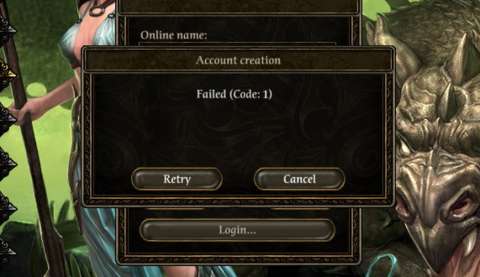
This can be a disappointment to players who are looking for more value from the game.
If the player could have a multiplayer match up and running, he/she would find that it has not changed much from Shadow Wars. Players still pick a faction and pick a hero type which he/she would use; any hero still has pre-set equipment and skills and is at level 30.
SINGLE-PLAYER CAMPAIGN – IN GENERAL:
With the lackadaisical skirmish and multiplayer modes described, this review would move on to the metaphorical meat of the game: its single-player campaign.
As mentioned earlier, the player character is a former Rune Warrior, out to atone for his/her past misdeeds, even though these were forced onto him/her due to the Rune bindings (which are better explained through the first game).
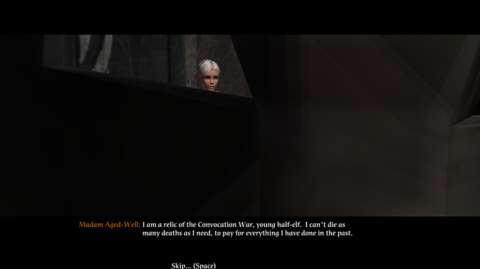
Throughout the campaign of Dragon Storm, the protagonist is accompanied by a party of characters, some of whom he/she already knew and a few whom he/she does not. This party of characters is the player’s main asset. Fortunately, there are adequate features to manage them.
More frequently than not, the player is given the opportunity to build up a base and raise an army. This is more of a necessity in Dragon Storm than it was in Shadow Wars, because the opposition is considerably stiffer this time around. This becomes even more so if the player has selected any difficulty setting higher than “normal”.
Other than that, there is the usual RPG element of getting loot and gear for party members and kitting them out for maximum effectiveness.
MAGICAL DEUS EX MACHINA:
Magic is a very convenient inclusion in stories with fantastical settings. Less-than-imaginative writers would often use magic to explain away canonical inconsistencies, or where logic and physical limitations act as obstacles to the design of solutions for narrative problems.
For better or worse (usually the latter), magic would be used in such a manner in Dragon Storm’s story.
One of the better ones is the feature of Journey Stones. This was convenient in Shadow Wars, and is still so in Dragon Storm. It is mentioned in the story as one of the convenient abilities of the Shaikan (though apparently only to a select few). According to an exposition in the Free Game mode, the Shaikan have erected Journey Stones on each island to facilitate their life as mercenaries and to compensate for the loss of Eo’s portals.
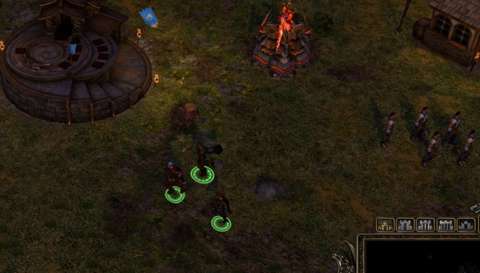
Unfortunately, the use of magic cause issues of believability in other cases. Of course, it can be argued that this is magic after all, but there are times when the extent of the convenience of magic can seem too eye-rolling typical.
For example, magic is used to explain away the method for people aboard a floating city to disembark onto islands, without having to bring the city close to the latter and without having to use convincingly maritime means of commuting, such as rafts.
The magical properties of dragon-blood are also used to explain away the inclusion of the Blades as a Shaikan sub-faction. The Blades were automatons which were previously described as difficult to animate, and dragon-blood – of which the Shaikan have lots of – happens to be a conveniently alternative to the original means.
That the inventor of the Blades, who have been described as malevolently brilliant, has never thought of using dragon-blood can be difficult to accept.
MERCHANTS:
Like in previous SpellForce titles, there are individuals who stock items for sale and buy stuff which the player does not want.
The buyback feature also returns, but together with its limitations too; the merchants do not retain items which the player has sold to them after the player has loaded another map. On the other hand, the player would not have a hard time trying to figure what to keep and what to sell. (There will be more elaboration on this shortly.)
Unfortunately, merchants are still individuals who stand in place all the time doing nothing but idling animations. This makes them difficult to appreciate, especially for players who had encountered merchants with much livelier character in other games with RPG elements.
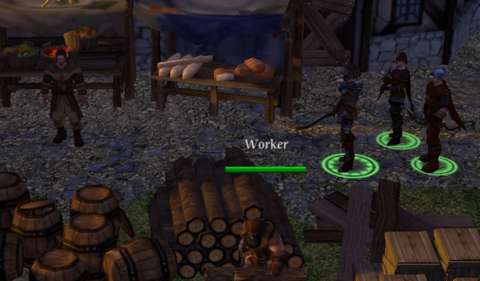
TRASH BY VENDORS & VENDOR TRASH:
For better or worse, the long-time RPG trope of “the best stuff are found, not bought” rings true in Dragon Storm. Most of the items which merchants stock are no better than what the player would get from looting treasure chests around maps. The player who had been saving money to buy expensive things before the end-game would be quite disappointed to know that there is not much to be coveted from merchants.
Unfortunately, most of the stuff which the player would find are useless too. This “vendor trash” are generally found on treasure chests sitting around maps. This can seem to give the impression that the player is not well rewarded for putting in the effort to explore maps (which is not easy, due to the lousy camera).
QUESTS:
Doing quests is a staple of games with RPG elements, and SpellForce is no different. Unfortunately, SpellForce has never had many sophisticated quests. What it lacks in complexity, it makes up with quantity – and not for the better.
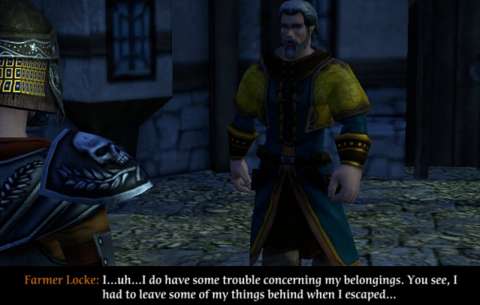
There are a lot of quests which have the player picking things up to bring them somewhere; these are as numerous as those which have the player killing things. If the quests which the player gets are not these, they would be quests which have the player going somewhere to get into fights, or going somewhere to talk to them someone – and usually fight some more.
These typical quests would have been bearable if there had been wittier writing or more exciting presentation, but SpellForce is not known for either at the time of Dragon Storm.
The tedium of these kinds of quests only gets worse as the playthrough progresses, especially in campaign mode. They can get to the point that they seem like slogs.
That is not to say that all of the quests which the player would get are boring. There are a few well-designed examples, such as a campaign-related one which has the player controlling an invisible unit, which is used to place bombs.
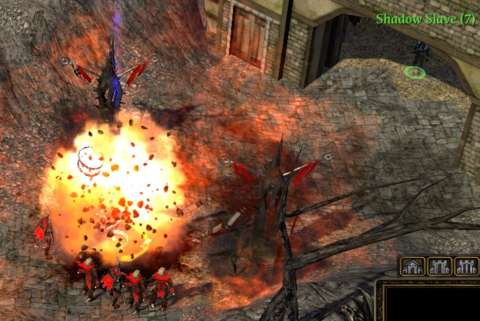
Unfortunately, these more interesting activities become fewer and fewer as the playthrough progresses. They are steadily replaced with the aforementioned run-of-the-mill ones.
At the very least, completing quests tend to reward the player with powerful pieces of gear, which usually surpass anything which merchants sell and which the player finds in the field. This makes for a good incentive to endure the more boring quests.
Most of the quests which the player would receive have enough details in their descriptions that the player would know what to do. For example, there is a certain scenario in the campaign where the player has to knock out magical power sources on isolated islands, which can be more easily reached with flying units.
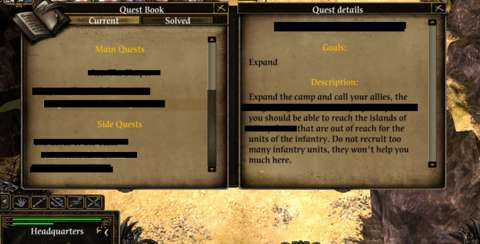
Yet this convenience is held back by translation issues, one of which can be seen in the screenshot above, e.g. the line “out of reach for the units of the infantry”. There will be more elaboration on translation issues later.
LONG-TERM QUESTS:
The SpellForce series has a liking for long-term quests, and Dragon Storm is not an exception. The ones in Dragon Storm are usually used for the quests concerning the protagonists’ companions in the campaign mode.
There are long-term quests which can seem to be a drag though. For example, there is one in the campaign mode which has the player picking up seemingly useless things.
To cut the game some slack, these objects are actually reminders of what has happened in the first SpellForce game, including its expansion. Yet, this quest would only be amusing to people who have fond memories of the first game, which was not exactly universally loved.
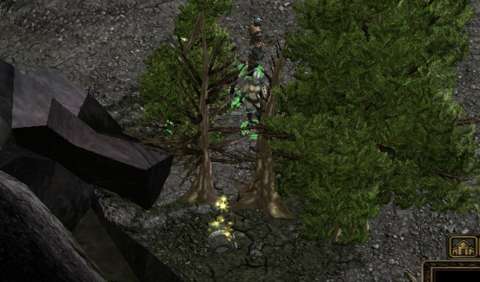
There are also long-term quests in Free Game mode, but these epitomise the monotony of the quests in the SpellForce series. In fact, most of these can be perceived as grinding-heavy quests, especially those which require the player to meet quotas of the same objectives.
(There will be more elaboration on the Free Game mode – and not in praise of it.)
CAMPAIGN COMPANIONS:
Shadow Wars differentiated itself from its flawed predecessor with characters who are adequately entertaining, namely the protagonists’ companions. Dragon Storm does not have as many entertaining characters, which is made all the more apparent by the fact that there are recurring characters from the first game who return but are not as amusing as they were before.
Examples of these include Mordecay (named “Mordecai” previously). He is still a bitter person, but gone is his boisterousness. The poster-girl of Shadow Wars, who is the dark-elf princess-turned-empress Nightsong, also returns, but she takes a backseat to the story.
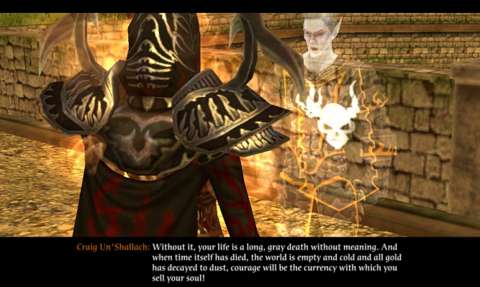
Some of the new companions are not entertaining either. Wind and Whisper feel like a lot of wasted opportunities, considering that they are half-elves who are also Shaikan; they have their own story quests, but these involve killing things and they have rather lackadaisical voice-acting. Yasha Ashir is mostly annoying, even if she is instrumental in explaining the backstory of one of the Shaikan sub-factions.
The only companion who has an inkling of amusement to offer is Caine, a certain character with otherworldly connections. The quests which concern him are quite entertaining, because they teeter in the grey regions of morality. Such quests are rare occurrences in the SpellForce series.
Interestingly, companions can act as NPCs to a degree, which is not exactly the case in Shadow Wars. When this occurs, question marks appear above their heads, allowing the player to talk to them, usually to receive quests.
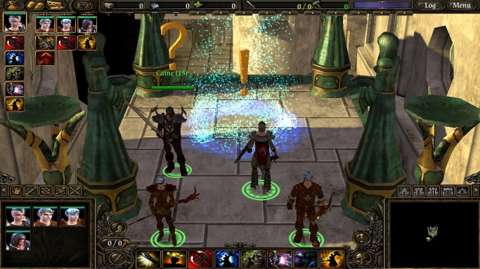
CAMPAIGN TWEAKING IN GOLD EDITION:
In the launch version of SpellForce 2, i.e. Shadow Wars, the player can attempt to do secondary quests while dealing with the primary objective at the same time in the campaign mode. In Dragon Storm’s campaign mode, the player does not always get to do this.
To be specific, in Dragon Storm, the player is not allowed to trigger secondary quest events which spawn enemies. In retrospect, this deliberate limitation prevents the player from making the mistake of dealing with two enemy forces at once.
However, there are some scenarios which disable the player’s ability to use armies after the primary quests for a map have been achieved. This occurrence is not desirable when there are secondary quests which trigger the spawning of enemy forces.
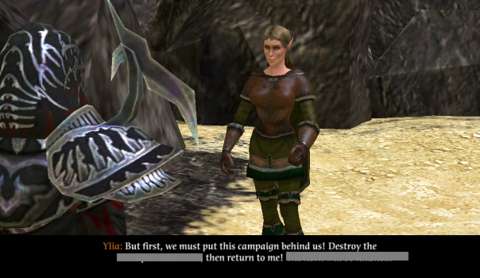
FREE GAME MODE:
Free Game mode was already in Shadow Wars. As a recap, it was intended to create an MMO-like experience in which the player maintains an “account” of sorts which tracks the player’s progress. The player can load maps to play standalone scenarios, and also retry them to grind for the achievement of objectives or for additional experience.
Consequently, Free Game mode was a tedious grind in Shadow Wars, and still is Dragon Storm.
This is a disappointment, because Free Game mode actually has a story to tell, namely how the Shaikan have learned to cope since the fall of their former home.
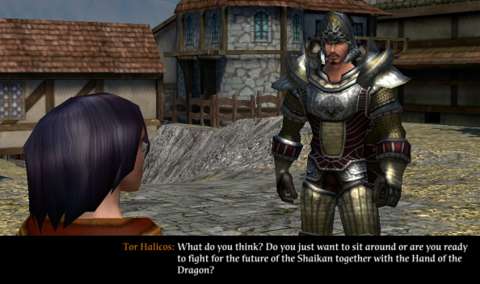
Dragon Storm does add some new maps to the roster of scenarios, an additional option for a starting party (which uses the Shaikan skill tree) and some new quests. However, it also retains the flaws of Free Game mode, chief of which is a complete lack of a game-saving feature.
Some of the scenarios can be rather long and Free Game mode is single-player, so this limitation is difficutlt to appreciate. That JoWood never saw this as a problem is also disappointing.
At the very least, starting Free Game mode using the Dragon Storm pack starts the player character off at level 15, and also gives the player a full party right from the get-go (albeit messing up one of the quests of Free Game mode, the one which concerns the gaining of additional party members). This turns the low-level scenarios into push-overs, but this also highlights the tedium of the quests in Free Game mode.
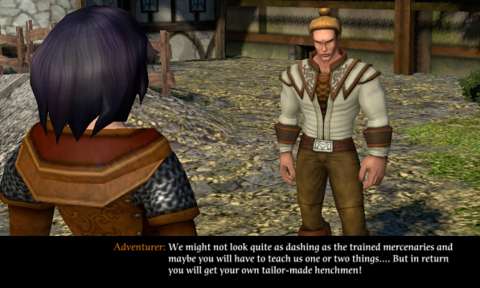
POSSIBLE UNDEAD FACTION:
In both the Free Game and Campaign modes, the player may notice that some maps feature Undead forces – specifically Undead forces which are capable of building bases, harvesting resources and erecting graveyards and mausoleums all over the place.
Oddly though, despite the fact that this Undead “faction” appears fully functional, the player is not given the option of playing with the Undead faction.
LONG LIST OF COMPLAINTS:
To call Dragon Storm a flawed product is an understatement. Most of the problems which will be subsequently described had been in Shadow Wars, and had never been addressed.
SCREEN RESOLUTION ISSUES:
Dragon Storm starts itself off by revealing problems in how it handles screen resolutions – right from the start and in the intro cutscene for the campaign mode, in fact.
Since Shadow Wars, the screen resolution options are still limited to just 800 by 600 and 1024 by 768 pixels – even at the time of the Gold Edition of Spellforce 2, which came out in 2009. If the player is using graphical peripherals which do not operate at these resolutions, the game may well crash in the intro cutscene.
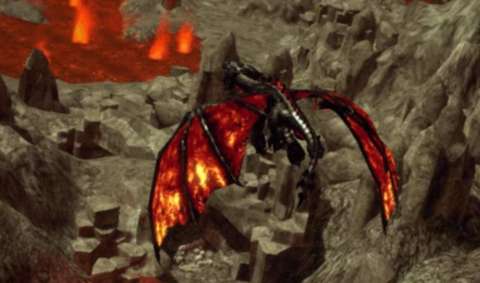
To address this issue, the player has to fiddle with the configuration files in the game’s installation directory, inputting numbers which match the native resolution of the graphical assets of the player’s computer. This can be a hassle, one which the developers could have mitigated by revisiting the graphical designs of the game.
The game also lacks an option for windowed mode. Fortunately, the game does seem to take switches to the OS desktop without too much of a hassle.
INCOMPATIBILITY WITH NEWER HARDWARE:
As with screen resolution, the developers of the game have never seen it fit to update the game to support newer hardware. The game fails to recognize said newer hardware, resulting in it picking lousy visual and audio settings when launching the game the first time around.
Addressing this issue requires even more tinkering with the game’s files outside of the game proper. It is more prudent for the player to manually select the settings himself/herself, but this does not change the fact that the game has useless automatic settings.
LOUSY CAMERA:
The camera was a problem in Shadow Wars due to in its inability to give the player a good view of what he/she needs to look at when it is over tall objects, such as mountains and citadels. It Is just as incapable at this in Dragon Storm; the player must manually wrangle the camera to get an adequate view.
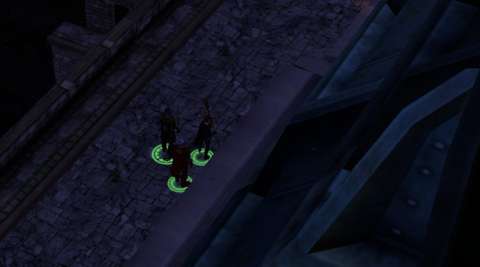
The game offers the option for an over-the-shoulder third-person camera. This was intended to bolster the impression that the game is an RPG, though a third-person camera is of course not exactly something which defines an RPG.
It is quite impractical, because of a few reasons. The first of these is that the camera has no provisions for when it goes behind an obstacle; the obstacle remains opaque. The second is the limited zoom, which is just not suitable for when there are scenarios which make use of the game’s real-time strategy elements. The third is that the camera is fixed at an angle which makes it not useful for looking uphill – and there are a lot of uphill slopes in the game.
Furthermore, the game does not exactly give the player many panoramic views to look at, because of the fog-of-war system which shrouds faraway places and dims the player’s view regardless of which camera orientation is used.
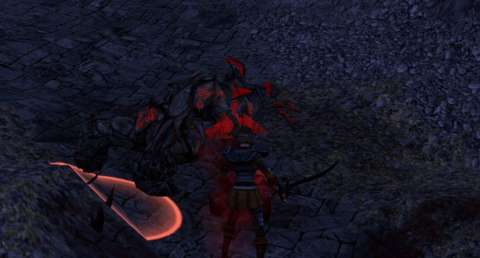
FOG-OF-WAR:
Speaking of the fog-of-war system, it had been troublesome in the first SpellForce, was problematic in Shadow Wars and is still a hindrance in Dragon Storm. This is mainly because of how slow fog-of-war is removed when the player’s units move in to clear it.
Specifically, there is a delay of a few seconds before the fog of war is removed. This does not affect units because they can see past fog of war and even opaque obstacles, but it does obscure the player’s view of what is up ahead anyway. There are a lot of scenarios where the player may just have the party turn around a corner and have it come under attack by unseen enemies around the corner, but are only able to see what is attacking them moments later.
JoWood has also used the fog-of-war to make some economical designs for graphical processing. To clarify, as long as the fog-of-war is hiding something from view, the game will not generate and display the model for it. Unfortunately, this also results in very ugly pop-ins. This can be seen when the player goes around the periphery of a city; sections of the walls pop in one after another.
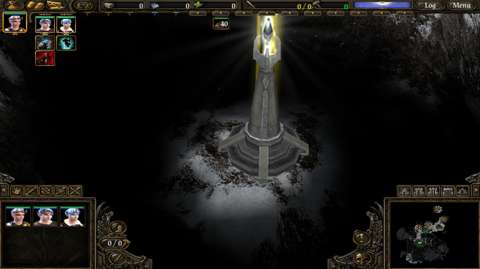
The fog-of-war system is more responsive once a region has been explored and returned to. The translucent fog-of-war which settles on an already-explored region of a map after the player’s units move away is a lot quicker to remove. This is of course a lot more conducive to gameplay, especially the RTS segment.
Another problem with the fog of war is that it has some odd rules about what can or cannot be seen through. Sometimes, the player’s units can reveal things past walls and other opaque obstacles. Yet, the player’s units cannot see through grills or gates which are made of bars.
In other cases, some objects can only be seen at certain angles. An example is shown in the screenshot below.
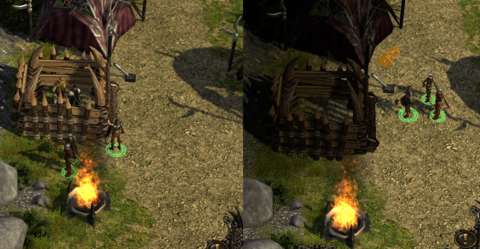
OPAQUE MODELS:
Spellforce 2: Shadow Wars was a decent-looking game for its time. However, by the time of Dragon Storm, which is one year ahead, its aging graphical designs are fast becoming more of a hindrance than a blessing.
Although Dragon Storm does have features which render objects which are blocking the player’s view of the action transparent or translucent, this only works when the camera is located within the object. If it is located behind an object which is obscuring something which the player wants to see, the object will not turn translucent.
This would not have been an issue if the objects in maps are not huge enough to obscure units, but they are, especially those in the city maps. The player must wrangle the camera to look around them.
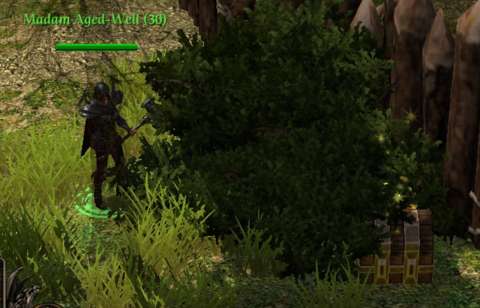
RTS SCENARIO STARTING PHASES:
The beginning of every real-time strategy scenario in any game mode starts the player off with at least a Headquarters building and/or a handful of workers, as well as some resources to make early-match plans with. Another important detail to such scenario beginnings is that all of the player’s units are idle, including the workers.
This is not always a problem; in fact, this is a gameplay-balanced start to multiplayer matches. Unfortunately, this is not a good thing in one particular campaign scenario.
In this campaign scenario, the player starts with his/her sprawled out bases already under attack. The bases are already well developed and the player has many workers available. However, the player must get resources as quickly as possible to fend off the constant and very early attacks, and the player’s party could not be everywhere at once.
This means the player must set each of the fifty or so workers to gather resources. The player can use the pause feature to reduce time spent switching the camera all over the map, but the start of this scenario remains the most tedious experience of the campaign mode.
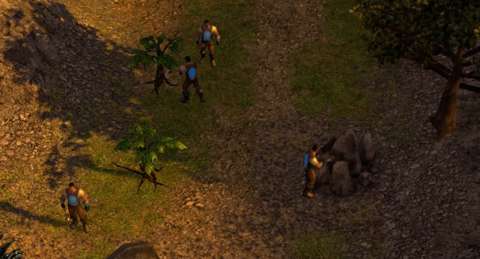
INADEQUATE MINI-MAP:
As a game with RTS elements, SpellForce 2 has a mini-map, but even up to the Gold Edition, it remains unwieldy and barely useful.
The biggest problem with the mini-map is its lack of contrast for terrain details. In the mini-map, every piece of ground looks like a shade of grey with some colour or another, but still mainly grey and thus blending with each other. Even water looks grey, albeit with tints of blue.
The grey terrain in the mini-map is also hard to differentiate from the fog-of-war, both of the black sort which shrouds unexplored regions and the further grey shading which denotes that a region is out of the view of the player’s units or buildings.
The game does attempt to have some handy visual indicators, such as purple dots for merchants, gold dots for quest indicators and white dots for conversation options with characters or interactions with objects.
The problem with them though is that their appearance on the mini-map is inconsistent. Gold dots always appear on the map, but the other dots are obscured by the fog-of-war. This means that if the player is not thorough in searching the map, he/she could miss out on some side quests. The player also must remember where the merchants are.
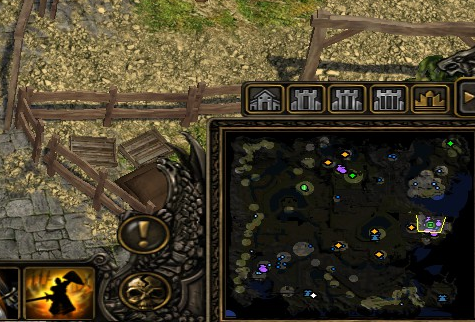
SAVE-GAME BUG:
In the launch version of the expansion pack, there was some incompatibility between the original package of the game and the expansion pack. This was more apparent if the player had not completed the campaign of Shadow Wars before installing the expansion pack. Fortunately, patches have consolidated the differences between the two packages, and in the case of the “Gold” package for SpellForce 2, this does not happen.
Yet, this is only one of few instances when the developers actually paid attention to the state of the game.
LOADING SCREEN TEXT:
Dragon Storm provides some more backstory to flesh out the saga of the broken world that is Eo. It does this through the loading screens for the campaign maps; whenever the player loads a map for the first time, i.e. practically advancing the story, the player is treated to a loading screen with some text. This text is usually written by once-influential people, like Darius and the tragically fated circle mage Rohen.
These bits also tend to be the best-written text in the game, and that’s not actually praising the game much; if the player is a veteran of fantasy games, he/she may well have read something similar.
That is, if he/she could read the text at all. The problem here is that the loading progress bar obscures the last passages of particularly long text.
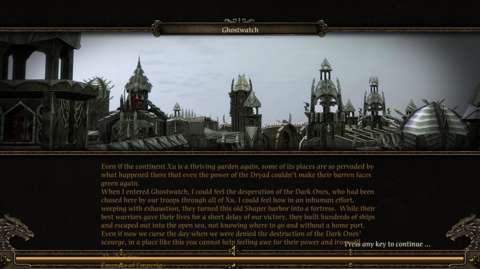
TOOLTIPS:
When the player hovers the cursor over an icon, the player is shown the tooltip which describes what that icon does. This can be seen when examining items in the player’s inventory.
The tooltip system is useful most of the time. For example, there is the aforementioned inventory; in this tab, the tooltip shows the statistics of the item being examined and that of the item which the current character has equipped, if any. The tooltip for this occasion is mostly adequate, though it could have benefited from more visual indicators, such as colouring for when the statistics of the examined item are better than those for the currently equipped one.
Unfortunately, the tooltip system falters in other cases, suggesting that the developers did not stress-test it. As an example, some of the tooltips for skill icons in the skill tree screens are so long in the vertical direction that the text for the descriptions of the benefits from their basic levels are out of the screen.
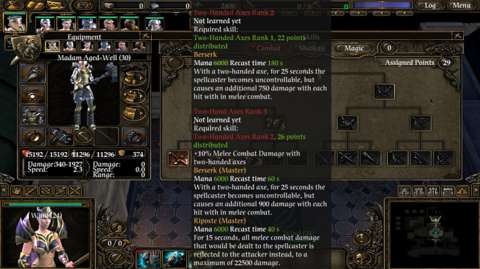
DUMB NPCS:
The player will be seeing a lot of NPCs in the Campaign and Free Game modes. The player will also be seeing them stand around doing nothing while waiting for the player to take interest in them.
The game does not make it easy for the player to believe that they are nothing more than just animated and scripted objects (which they technically are).
NPCs have scripts which mark them as characters who will either participate in combat (to any degree), or absolutely not at all, in the literal sense.
One way to know this is to see whether tooltips come up when the player hovers the mouse cursor over their unit portraits on the bottom left of the screen. If something comes up, this something is usually a list of statistics which are pertinent to combat; this means that they can fight, or at least be attacked by enemies.
If nothing comes up, they are completely non-combat actors. They cannot fight, and cannot be attacked or damaged in any way either. This can sometimes result in some unbelievable scenes, even for a game with fantasy settings.
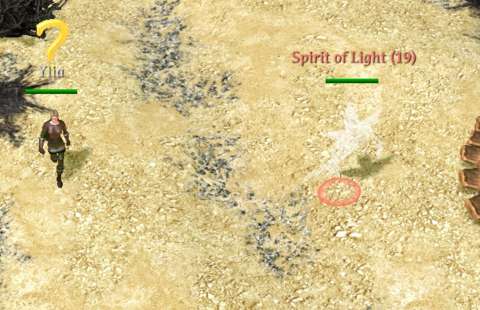
The NPCs which can fight or be attacked are even worse. If they are not already directly under the control of the player, they are controlled by the very clumsy and unwise A.I. They may get themselves into trouble, fighting enemies which are too powerful for them to defeat.
If they are not doing this, then they just stand around doing nothing while they are being attacked. This is especially so for NPCs whom the player must escort. Due to the aforementioned problems with the A.I.’s path-finding, they might get caught in a cluster of hostile enemies. Since any unit cannot pass through another, this means that such characters are very much doomed unless the player can free them.
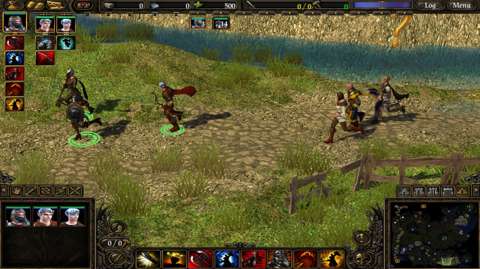
PRESENTATION ISSUES:
The SpellForce series has been known to try to weave tales which are not exactly cookie-cutter fantasy stories. After all, post-apocalyptic fantasy worlds, of which Eo can be considered one, are very rare in video games.
Unfortunately, the series often sabotages itself with lackadaisical presentation. Dragon Storm is not the game where this stops.
In Dragon Storm, there are times when the Campaign mode presents a scene which just seem disconnected from the current narrative at the time. The example of a soldier standing around doing nothing while her city is under siege is an example - and she is not the only one idling on his/her own two feet either.
There are also times when even the awareness of the fantastical settings of the game could not prevent the player from raising an eyebrow or two upon seeing an odd spectacle. An example is described in the following screenshot.
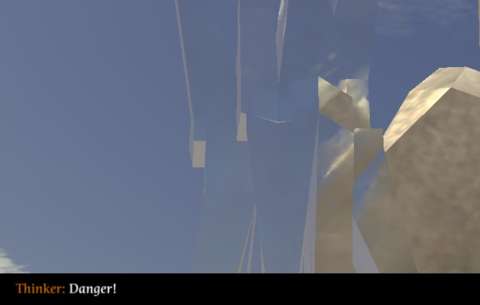
The worst of Dragon Storm’s presentation issues is its translation from its Deutsche roots. Most of the translation over to English is done well, of course, and where it is, it is relatively easy to comprehend.
However, there are times when the game’s voice-actors and –actresses utter lines which can seem bizarre. Giving their utterances some more thought would help bring sense to what is being conveyed, of course, but such flaws in the translation suggest that the play-testing of the game has not been thorough.
An example of such flaws is as follows.
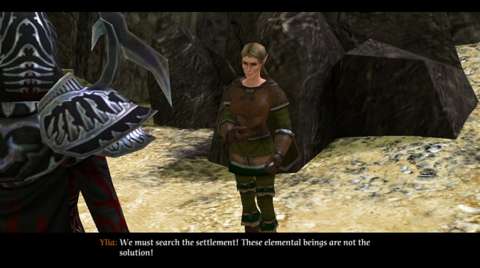
VOICE-ACTING:
Speaking of the voice-actors and –actresses, their skill is all over the place.
Some are adequately delivered, such as those by the voice talents for the protagonists. Melodramatic lines are also generally well-delivered with enough pomp.
Unfortunately, the voice-acting for some characters are sleepily delivered. The most emblematic of this is the voice-acting for Wind, one of the protagonist’s companions. The quests concerning her backstory are difficult to appreciate as a result.
Then there is voice-acting which is obviously not original, or even appropriate.
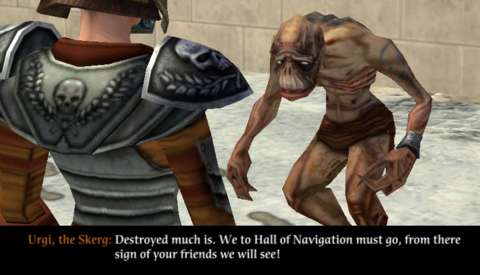
RECYCLED SOUND EFFECTS & MUSIC:
Most of the sound effects and musical soundtracks have been recycled from Shadow Wars. This can seem cheap to a jaded player. If there were new ones, they would not seem so much different from the existing ones, much less memorable.
Of course, one can argue that Dragon Storm is merely an expansion so one should not expect too much from it. Yet, a player who has seen expansion packs with greater value would not cut the game so much slack.
LIGHTING PROBLEMS:
SpellForce 2 was known for rather great lighting during its time. However, its lighting system is not as good at supporting gameplay as it is at being eye-candy.
The game is not very good at making transitions between day and night. Sometimes, dawn or dusk can be exceedingly dark, and can even dim the circles which highlight selected units. In some maps, the lighting may even flicker until the transition is complete.
Heavily walled-in areas do not make for well-lit environments, but the developers still use them for conversation-heavy cutscenes anyway, an example of which can be seen in the following screenshot.
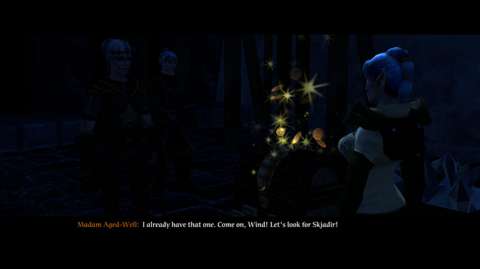
BROKEN SCRIPTS:
Even in the Gold edition of SpellForce 2, there are still bugs in the game.
To cut the game slack, there are at least no broken quests in the game. If the player has somehow broken one, it is the player’s fault. For example, there is one secondary quest which the player has to complete successfully by having a character who is under the player’s control survive a tough battle. If he dies, the quest ends prematurely.
However, the developers are not as attentive to non-quest-related scripts. There are at least two side endeavours which are not listed as side quests and which are broken. Both of these happen to occur in the map known as “Ghostwatch”.
One of these, if its bug triggers, results in loss of long-term opportunities. This concerns an NPC who would have followed the player into another map and who would have provided a reward if he has been kept alive long enough. However, if this bug triggers, he does not follow the player around.
The other bug concerns the failure of one clue to appear. This clue could have allowed the player to activate a certain edifice in the “Ghostwatch” map.
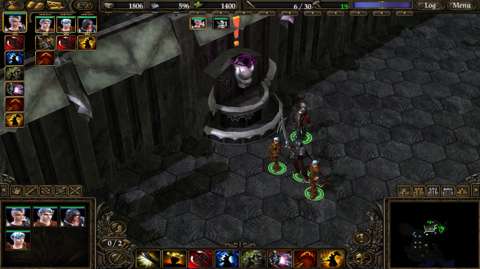
SLOW QUEST UPDATE NOTIFICATIONS:
Problems and tropes with the quests in Dragon Storm have been mentioned earlier. However, there is one more to add to the list: slow notifications for updates on quests.
When the player makes progress on a quest, the player is given a text update on which phase of the quest has been completed and which is the next one afterwards. However, every text update stays on for several seconds before it is replaced by the next one.
In the case of some primary quests, completion of a goal tends to complete other goals too, as well as grant the player character a level. This can lead to a string of notifications which can last for a minute or two, complete with sound effects for them.
At first, this can seem amusingly silly, but it would become grating later, especially when the player realizes that the notifications are actually tied to the data on a map.
To elaborate, if the player has left a map by completing a main quest, he/she would not be given notifications on the completion of that quest and any other notifications associated with the completion of that quest (including those for level gains) because he/she has transitioned to another map.
Instead, if he/she returns to that map later, he/she would be bombarded with those notifications, possibly much, much later when those notifications have become useless.
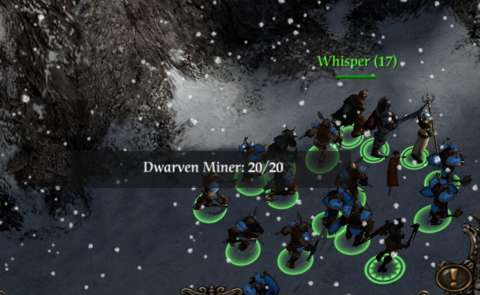
Actually, this problem has been in SpellForce 2 since Shadow Wars. This does not make it less worse, of course, but it does show that JoWood does not consider this to be an issue.
SILVER LINING:
Even though complaint after complaint has been made earlier, there is some entertainment to be had from the game.
Although the game has problems such as translation issues which hurt its writing, there are some amusing scenes. For example, there are conversations regarding the dwarves’ bluntness and seeming lack of any sense for danger.
Then, there are re-acquaintances with characters from the previous game. Most of them are NPCs in this game, but knowing about their fates would give veterans of Shadow Wars some closure; there is also a peculiar plot twist concerning the protagonist of Shadow Wars, and this happens to contribute to the significance of Dragon Storm’s title.
There are also some peculiar sights in the game. One of the best examples of these can be seen in the following screenshot.
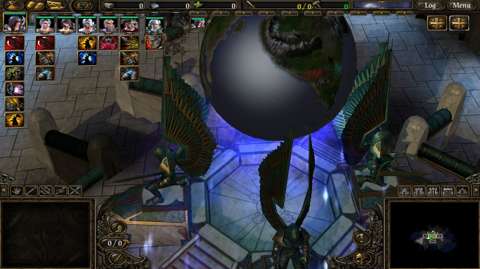
CONCLUSION:
There are few good things to say about Dragon Storm. Although Shadow Wars deserved its praises for being a tremendous improvement over the previous SpellForce title, Dragon Storm does not add much of anything excitingly new. The Shaikan faction and the Shaikan skill tree are not game-changing additions either.
Dragon Storm also retains the mediocre and poor designs of Shadow Wars, virtually all of which have been described earlier, together with the rather prominent use of the phrase “unfortunately” in this review. More importantly, these many rough edges have never been polished out over the years. (Some were even retained in the next two expansions.)
SpellForce 2 has not aged well, and Dragon Storm only seems to reinforce this impression further.
P.S. As mentioned earlier already, there is no longer any official support for online multiplayer. This reminder is necessary because the value of the game may come off as reduced as a result of the lack of official support. Online multiplayer is still workable through third-party means, though of course these means are legally dubious.
